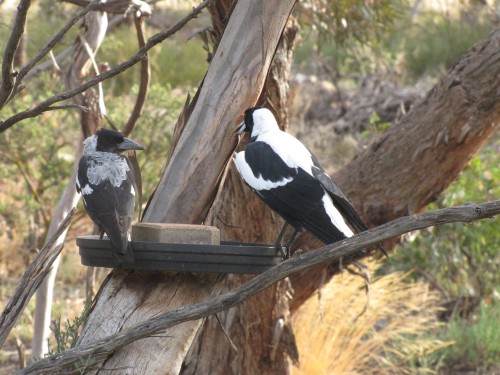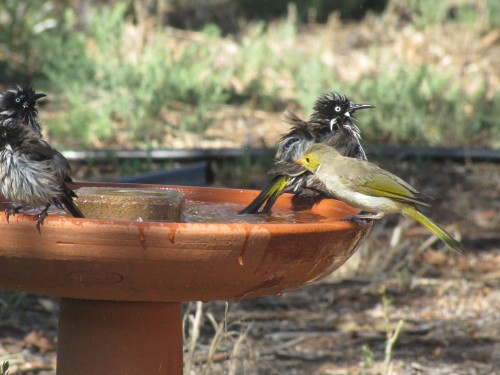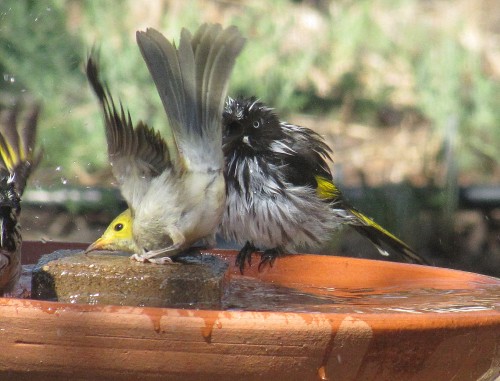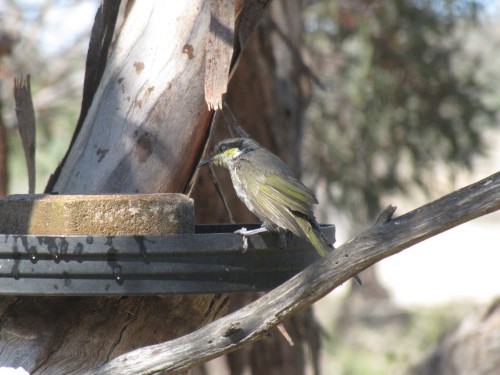Australian Magpies at the bird bath
We have quite a few resident Australian Magpies in our garden and on our five acre property. Every year we watch out for nest building time to see which tree they will use; sometimes they refurbish an old nest.
In the hot weather anything up to 6 or 7 of them gather under the shade of our back veranda, often crouching under the easy chairs we have there for extra coolness. The sun in the open on hot days can be as high as 50C or more, while under the veranda it can be 10 degrees cooler – which is still very hot!
Our bird baths are also very popular with all species. Most smaller birds tend to fly off when the magpies occupy the cooling water.
In the photos shown today, the bird on the left is a juvenile, possibly a female. The one on the right is a mature male.
Yellow Thornbills at our bird bath
The most common thornbill species in our garden is the Yellow-rumped Thornbill. This is a resident breeding species and we see small flocks of up to 20 almost every day. If we searched our whole property we would probably see them every day.
Less common is the Yellow Thornbill shown in today’s photos. This species, also known as the Little Thornbill, is a regular visitor. On a recent hot day a small flock came hesitatingly to our bird bath. Some of the larger birds such as the honeyeaters can be quite bossy and this makes this tiny visitor nervous and flighty, so I was pleased to get a series of close up photos.
As an added bonus, I managed to catch one of them landing but still in flight – check out the last photo below.
White Plumed Honeyeater comes for a bath
Over recent days I have been writing about and showing photos of various birds coming to visit our birdbath. Usually the New Holland Honeyeaters dominate proceedings, making a terrible din and splashing water everywhere.
On this occasion a solitary White Plumed Honeyeater forced its way in , running the gauntlet of the mob. I am not sure what it is doing in the photo below. Almost seems like it has landed awkwardly. It’s probably just flapping its wings and I caught it in an unusual pose.
Singing Honeyeater at the birdbath
Yesterday I wrote about New Holland Honeyeaters bathing in our bird bath (click here to view that post).
While the New Hollands are by far the most frequent and noisiest of the visitors to the bird bath, many other species also come to bathe or drink during our hot spells in summer. The New Holland Honeyeaters may come individually, but they are more prone to come in a flock of a dozen or more. The result is usually very noisy – and water sprays everywhere.
By way of contrast, the Singing Honeyeater shown in today’s photo quite often comes alone, or at most, two. They tend to be far more solitary birds in our garden. They often wait a short distance away while other species drink, then slip in quietly to drink when calmness returns.
Hot weather birding
We are currently experiencing another heatwave. Tomorrow is forecast to be the 11th consecutive day over 30C; some of the days – like today – the temperature has reached 40C (104F). During such days I add a bucket of fresh rainwater to the various birdbaths we have in our garden. Several of them are in clear view of where we often sit to eat, or to enjoy some reading. Sometimes I even do my writing there; it gives me a break from my office and I have a different view. The camera is usually ready for action, so on occasions I neglect my writing and attend to some serious bird photography.
During the current heatwave the birds have been coming daily to drink, bathe and generally have a good time. The parade of species is impressive. We sometimes have up to a dozen different species come to drink in a 10 or 15 minute period. Last week I captured a series of photos of about a dozen New Holland Honeyeaters having a great time cooling off in the water. Droplets fly in all directions and some are left looking absolutely drenched.
For more photos like this one click here.













